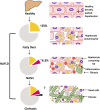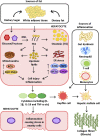Non-Alcoholic Steatohepatitis: A Review of Its Mechanism, Models and Medical Treatments
- PMID: 33343375
- PMCID: PMC7745178
- DOI: 10.3389/fphar.2020.603926
Non-Alcoholic Steatohepatitis: A Review of Its Mechanism, Models and Medical Treatments
Abstract
Non-alcoholic steatohepatitis (NASH) develops from non-alcoholic fatty liver disease (NAFLD). Currently, around 25% of the population is estimated to have NAFLD, and 25% of NAFLD patients are estimated to have NASH. NASH is typically characterized by liver steatosis inflammation, and fibrosis driven by metabolic disruptions such as obesity, diabetes, and dyslipidemia. NASH patients with significant fibrosis have increased risk of developing cirrhosis and liver failure. Currently, NASH is the second leading cause for liver transplant in the United States. More importantly, the risk of developing hepatocellular carcinoma from NASH has also been highlighted in recent studies. Patients may have NAFLD for years before progressing into NASH. Although the pathogenesis of NASH is not completely understood, the current "multiple-hits" hypothesis suggests that in addition to fat accumulation, elevated oxidative and ER stress may also drive liver inflammation and fibrosis. The development of clinically relevant animal models and pharmacological treatments for NASH have been hampered by the limited understanding of the disease mechanism and a lack of sensitive, non-invasive diagnostic tools. Currently, most pre-clinical animal models are divided into three main groups which includes: genetic models, diet-induced, and toxin + diet-induced animal models. Although dietary models mimic the natural course of NASH in humans, the models often only induce mild liver injury. Many genetic and toxin + diet-induced models rapidly induce the development of metabolic disruption and serious liver injury, but not without their own shortcomings. This review provides an overview of the "multiple-hits" hypothesis and an evaluation of the currently existing animal models of NASH. This review also provides an update on the available interventions for managing NASH as well as pharmacological agents that are currently undergoing clinical trials for the treatment of NASH.
Keywords: animal models; metabolic syndrome; non-alcoholic fatty liver disease; non-alcoholic steatohepatitis; obesity; pharmacological treatments; steatosis.
Copyright © 2020 Peng, Stewart, Woodman, Ritchie and Qin.
Conflict of interest statement
The authors declare that the research was conducted in the absence of any commercial or financial relationships that could be construed as a potential conflict of interest.
Figures



Similar articles
-
Progression of non-alcoholic steatosis to steatohepatitis and fibrosis parallels cumulative accumulation of danger signals that promote inflammation and liver tumors in a high fat-cholesterol-sugar diet model in mice.J Transl Med. 2015 Jun 16;13:193. doi: 10.1186/s12967-015-0552-7. J Transl Med. 2015. PMID: 26077675 Free PMC article.
-
Non-alcoholic fatty liver disease: An overview of risk factors, pathophysiological mechanisms, diagnostic procedures, and therapeutic interventions.Life Sci. 2021 Apr 15;271:119220. doi: 10.1016/j.lfs.2021.119220. Epub 2021 Feb 13. Life Sci. 2021. PMID: 33592199 Review.
-
Non-Alcoholic Fatty Liver Disease, an Overview.Integr Med (Encinitas). 2019 Apr;18(2):42-49. Integr Med (Encinitas). 2019. PMID: 31341444 Free PMC article. Review.
-
Impact of dietary fat on the development of non-alcoholic fatty liver disease in Ldlr-/- mice.Proc Nutr Soc. 2016 Feb;75(1):1-9. doi: 10.1017/S002966511500244X. Epub 2015 Aug 18. Proc Nutr Soc. 2016. PMID: 26282529 Free PMC article.
-
The use of statins alone, or in combination with pioglitazone and other drugs, for the treatment of non-alcoholic fatty liver disease/non-alcoholic steatohepatitis and related cardiovascular risk. An Expert Panel Statement.Metabolism. 2017 Jun;71:17-32. doi: 10.1016/j.metabol.2017.02.014. Epub 2017 Mar 4. Metabolism. 2017. PMID: 28521870 Review.
Cited by
-
Transcriptome changes in stages of non-alcoholic fatty liver disease.World J Hepatol. 2022 Jul 27;14(7):1382-1397. doi: 10.4254/wjh.v14.i7.1382. World J Hepatol. 2022. PMID: 36158924 Free PMC article.
-
Fibroblast Growth Factors for Nonalcoholic Fatty Liver Disease: Opportunities and Challenges.Int J Mol Sci. 2023 Feb 26;24(5):4583. doi: 10.3390/ijms24054583. Int J Mol Sci. 2023. PMID: 36902015 Free PMC article. Review.
-
Amelioration of non-alcoholic fatty liver disease by targeting adhesion G protein-coupled receptor F1 (Adgrf1).Elife. 2023 Aug 15;12:e85131. doi: 10.7554/eLife.85131. Elife. 2023. PMID: 37580962 Free PMC article.
-
Huanglian-Hongqu herb pair improves nonalcoholic fatty liver disease via NF-κB/NLRP3 pathway in mice: network pharmacology, molecular docking and experimental validation.Hereditas. 2024 Apr 3;161(1):12. doi: 10.1186/s41065-024-00316-0. Hereditas. 2024. PMID: 38566171 Free PMC article.
-
Hepatoprotective Effects of a Natural Flavanol 3,3'-Diindolylmethane against CCl4-Induced Chronic Liver Injury in Mice and TGFβ1-Induced EMT in Mouse Hepatocytes via Activation of Nrf2 Cascade.Int J Mol Sci. 2022 Sep 27;23(19):11407. doi: 10.3390/ijms231911407. Int J Mol Sci. 2022. PMID: 36232707 Free PMC article.
References
-
- Alexander M., Loomis A. K., Lei J. van. der., Duarte-Salles T., Prieto-Alhambra D., Ansell D., et al. (2019). Risks and clinical predictors of cirrhosis and hepatocellular carcinoma diagnoses in adults with diagnosed NAFLD: real-world study of 18 million patients in four European cohorts. BMC Med. 17, 95 10.1186/s12916-019-1321-x - DOI - PMC - PubMed
Publication types
LinkOut - more resources
Full Text Sources

